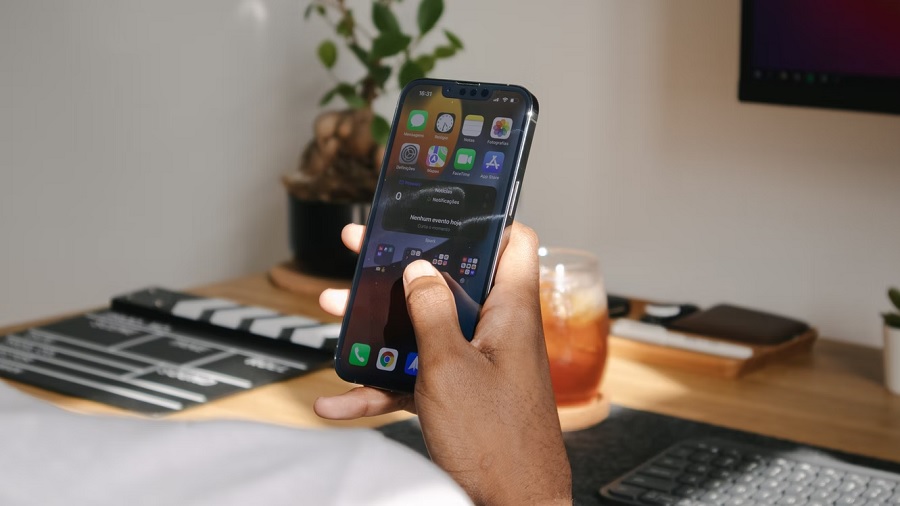The list of exclusive features expected for the iPhone 14 Pro models just got a new entry. Apple is reportedly planning on finally adding the always-on display to the iPhones later this year, but only to the premium devices.
Apple has brought the always-on display mode to the more recent models of the Apple Watch, but it has yet to debut on the iPhone. That could change in the coming months, though. Bloomberg’s Mark Gurman reports in the latest edition of the Power On newsletter that the iOS 16 will roll out with support for the display feature.
The tech giant is expected to make the always-on display mode available on the iPhone 14 Pro and iPhone 14 Pro Max only. While this could add value to the premium models, its exclusivity to the high-end phones likely has a technical explanation as well. The same report said the always-on display mode would work by significantly lowering the frame rate when the phone is on the lock screen. This allows the device to constantly display a few information, like the time and date on Apple Watch, without consuming much of the battery.
The iPhone 14 Pro models are shaping up to have some significant advantages over the standard models iPhone 14 and iPhone 14 Max. Aside from the always-on display mode, the Pro variants are expected to be the only phones in the series with the ProMotion adaptive refresh rate. The feature was first brought to the iPhones last year, which allows the iPhone 13 Pro and iPhone 13 Pro Max to support up to 12 refresh rates between 10Hz and 120Hz.
Apple is also expected to introduce a new design by replacing the notch with a pill-and-hole cutout for the selfie camera and the Face ID. Like the features mentioned above, this is also expected to be implemented on the iPhone 14 Pro and iPhone 14 Pro Max only.
Earlier this year, analyst Ming-Chi Kuo also reported that the iPhone 14 Pro models are likely the only phones in the 2022 lineup to be powered by the new A16 Bionic chip. The iPhone 14 and iPhone 14 Max, on the other hand, are expected to keep using the A15 SoC.
Photo by Nubelson Fernandes on Unsplash



 EU Prepares Antitrust Probe Into Meta’s AI Integration on WhatsApp
EU Prepares Antitrust Probe Into Meta’s AI Integration on WhatsApp  Hikvision Challenges FCC Rule Tightening Restrictions on Chinese Telecom Equipment
Hikvision Challenges FCC Rule Tightening Restrictions on Chinese Telecom Equipment  Samsung Launches Galaxy Z TriFold to Elevate Its Position in the Foldable Smartphone Market
Samsung Launches Galaxy Z TriFold to Elevate Its Position in the Foldable Smartphone Market  Norway’s Wealth Fund Backs Shareholder Push for Microsoft Human-Rights Risk Report
Norway’s Wealth Fund Backs Shareholder Push for Microsoft Human-Rights Risk Report  Intel Boosts Malaysia Operations with Additional RM860 Million Investment
Intel Boosts Malaysia Operations with Additional RM860 Million Investment  Australia Releases New National AI Plan, Opts for Existing Laws to Manage Risks
Australia Releases New National AI Plan, Opts for Existing Laws to Manage Risks  Nexperia Urges China Division to Resume Chip Production as Supply Risks Mount
Nexperia Urges China Division to Resume Chip Production as Supply Risks Mount  Wikipedia Pushes for AI Licensing Deals as Jimmy Wales Calls for Fair Compensation
Wikipedia Pushes for AI Licensing Deals as Jimmy Wales Calls for Fair Compensation  TSMC Accuses Former Executive of Leaking Trade Secrets as Taiwan Prosecutors Launch Investigation
TSMC Accuses Former Executive of Leaking Trade Secrets as Taiwan Prosecutors Launch Investigation  Morgan Stanley Boosts Nvidia and Broadcom Targets as AI Demand Surges
Morgan Stanley Boosts Nvidia and Broadcom Targets as AI Demand Surges  Apple Alerts EU Regulators That Apple Ads and Maps Meet DMA Gatekeeper Thresholds
Apple Alerts EU Regulators That Apple Ads and Maps Meet DMA Gatekeeper Thresholds  YouTube Agrees to Follow Australia’s New Under-16 Social Media Ban
YouTube Agrees to Follow Australia’s New Under-16 Social Media Ban  OpenAI Moves to Acquire Neptune as It Expands AI Training Capabilities
OpenAI Moves to Acquire Neptune as It Expands AI Training Capabilities  Amazon and Google Launch New Multicloud Networking Service to Boost High-Speed Cloud Connectivity
Amazon and Google Launch New Multicloud Networking Service to Boost High-Speed Cloud Connectivity  Coupang Apologizes After Massive Data Breach Affecting 33.7 Million Users
Coupang Apologizes After Massive Data Breach Affecting 33.7 Million Users  Apple Appoints Amar Subramanya as New Vice President of AI Amid Push to Accelerate Innovation
Apple Appoints Amar Subramanya as New Vice President of AI Amid Push to Accelerate Innovation  ByteDance Unveils New AI Voice Assistant for ZTE Smartphones
ByteDance Unveils New AI Voice Assistant for ZTE Smartphones 































